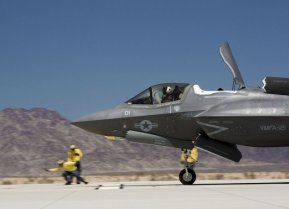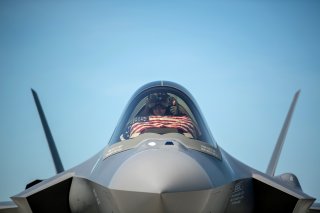This Is the Role the F-35 Stealth Fighter Jet Could Play in the Middle East
The F-35 fighter jets can function as a deterrent against Iran and, if needed, destroy Iranian ballistic-missile launch sites, establish air supremacy and even take out nuclear weapons development facilities if necessary.
The Air Force is sending a new air fleet of war-ready F-35 fighter jets to the Middle East to escort ships, deter potential enemies, conduct reconnaissance and, of course, support ongoing combat operations in the U.S. military's Central Command region.
Describing the deployment as the latest squadron to join the fight, an Air Force report said the operation marked the third time in approximately twelve months that F-35A Lightning IIs have been sent into combat.
“The 421st Fighter Squadron departed Hill AFB recently for Al Dhafra Air Base, United Arab Emirates, to support the United States Air Force Central Command mission in the region,” the Air Force report states.
As combat operations against the Islamic State and the Taliban have been decreasing or, in the case of the Islamic State, basically ended . . . the F-35s seem likely intended for training exercises, deterrence, force protection and ship escort. The Air Force report specifies the F-35s mission scope to include “defensive counter-air, maritime escort, deterrence and participation in multi-national exercises.”
That being said, the F-35 fighter jet has previously attacked the Taliban during its combat debut and is, according to its proponents, well suited for close air support (CAS). The Air Force has long intended to use the F-35 for CAS missions and, in a special Pentagon evaluation, assessed the F-35s in relation to the revered and combat-tested A-10 Warthog.
Some may think of the F-35 as perhaps overkill when it comes to CAS, or potentially more vulnerable than an A-10 if it, in fact, is hit by ground fire. However, many senior Air Force developers in favor of F-35 superiority when it comes to CAS missions point to its sensors, targeting systems, twenty-five-millimeter cannon and speed as attributes contributing to the F-35s combat performance.
Long-range, computer-enabled F-35 sensors could help the aircraft to see and destroy enemy ground targets with precision from much higher altitudes and much farther ranges than an A-10 could; the speed of an F-35, when compared to an A-10, would potentially make it better able to maneuver, elude enemy fire and get into position for attack; like the A-10's thirty-millimeter gun, the F-35 has its own twenty-five-milimeter cannon mounted on its left-wing which could attack ground forces; given its sensor configuration, with things like a 360-degree Distributed Aperture System with cameras, the F-35 brings a drone-like intelligence, surveillance, reconnaissance component to air-ground war. This could help targeting, terrain analysis, and much-needed precision attacks as U.S. soldiers fight up close with maneuvering enemy ground forces.
An F-35 might be better positioned to respond quickly to enemy force movement; in the event that enemy air threats emerge in a firefight, an F-35 could address them in a way an A-10 could not, obviously; an F-35 would be much better positioned to locate enemy long-range fires points of combat significance and destroy hostile artillery, mortar or long-range-fires launching points. Finally, while the A-10 has a surprising wide envelope of weapons, an F-35 could travel with a wider range of air-ground attack weapons—armed with advanced targeting technology. However, despite the potential efficacy of the F-35 for CAS, many believe it makes more sense to use less-expensive, non-fifth generation aircraft for missions where there are U.S. air supremacy and no ground threat.
All this being said, the deterrence posture for the F-35 is likely now geared for combat prospects well beyond CAS, as counterinsurgency efforts diminish and, in some areas, disappear. Also, the current environments in which the United States has been engaged in combat have been in areas without any kind of credible air defense threat. So, the F-35 fighter jets can function as a deterrent against Iran and, if needed, destroy Iranian ballistic-missile launch sites, establish air supremacy and even take out nuclear weapons development facilities if necessary.
Kris Osborn is the new Defense Editor for the National Interest. Osborn previously served at the Pentagon as a Highly Qualified Expert with the Office of the Assistant Secretary of the Army - Acquisition, Logistics & Technology. Osborn has also worked as an anchor and on-air military specialist at national TV networks. He has appeared as a guest military expert on Fox News, MSNBC, The Military Channel, and The History Channel. He also has a Masters Degree in Comparative Literature from Columbia University.
Image: Reuters


